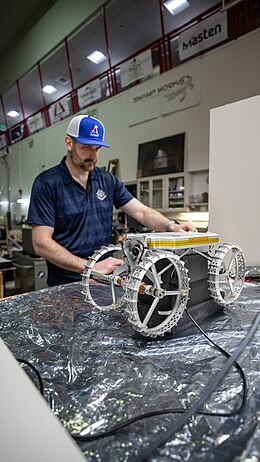


Astrobotic's CubeRover
| |
| Mission type | Technology demonstrator |
|---|---|
| Operator | Astrobotic Lab and Carnegie Mellon University |
| Website | www |
| Spacecraft properties | |
| Spacecraft | Iris[1][2] |
| Spacecraft type | Robotic lunar rover |
| Bus | CubeRover |
| Start of mission | |
| Launch date | 8 January 2024 07:18:36 UTC |
| Rocket | Vulcan Centaur VC2S |
| Launch site | Cape Canaveral SLC-41 |
| Contractor | United Launch Alliance |
| Moon rover | |
| Landing date | 23 February 2024 (originally planned) |
| Landing site | Planned: Mons Gruithuisen Gamma |
| Transponders | |
| Band | Wi-Fi |
| Instruments | |
| Two cameras with 1936 × 1456 resolution | |
CubeRover is a class of planetary rover with a standardized modular format meant to accelerate the pace of space exploration. The idea is equivalent to that of the successful CubeSat format, with standardized off-the-shelf components and architecture to assemble small units that will be all compatible, modular, and inexpensive.[3]
The rover class concept is being developed by Astrobotic Technology in partnership with Carnegie Mellon University, and it is partly funded by NASA awards.[3] A Carnegie Mellon University initiative - completely independent of NASA awards - developed Iris, the first flightworthy CubeRover. It was launched on 8 January 2024 along with Peregrine Mission One.[4] Surface operations phased out along with landing of Peregrine lander due to excessive propellant leak.[5]
The idea is to create a practical modular concept similar that used for CubeSats and apply it to rovers, effectively creating a new standardized architecture of small modular planetary rovers with compatible parts, systems, and even instruments so that each mission can be easily tailored to its objectives.[3][6][7] The rovers are expendable and do not use solar arrays for electrical power, depending solely on non-rechargeable batteries. This allows it to be lighter, have a larger cooling radiator panel for electronics, and have a simpler avionics design.[8]
The CubeRover program intends that standardizing small rover design with a common architecture will open access to planetary bodies for companies, governments, and universities around the world at a low cost, while increasing functionality, just as the CubeSat has in Earth orbit.[6] This would motivate other members of the space exploration community to develop new systems and instruments that are all compatible with the CubeRover's architecture.[3][6]
In May 2017 Astrobotic Technology, in partnership with Carnegie Mellon University, were selected by NASA's Small Business Innovation Research (SBIR) to receive a $125,000 award[9] to develop a small lunar rover architecture capable of performing small-scale science and exploration on the Moon and other planetary surfaces. During Phase I, the team built a 2-kg rover and performed engineering studies to determine the architecture of a novel chassis, power, computing systems, software and navigation techniques.
In March 2018, the team was awarded funds to move on to Phase II,[3][6] and under this agreement, Astrobotic and CMU were to produce a flight-ready rover with a mass of approximately 2 kg (4.4 lb).
In future missions, CubeRovers may be designed to take advantage of lander-based systems to shelter for the cold lunar night, that lasts for 14 Earth days.[6] Similarly, future larger CubeRovers may be able to incorporate thermal insulation and systems qualified for ultra-low temperatures.[6]
|
| |||||||||||||||
|---|---|---|---|---|---|---|---|---|---|---|---|---|---|---|---|
| Active |
| ||||||||||||||
| Past |
| ||||||||||||||
| Planned |
| ||||||||||||||
| Proposed |
| ||||||||||||||
| Cancelled |
| ||||||||||||||
| Related |
| ||||||||||||||
Missions are ordered by launch date. Sign † indicates failure en route or before intended mission data returned. | |||||||||||||||